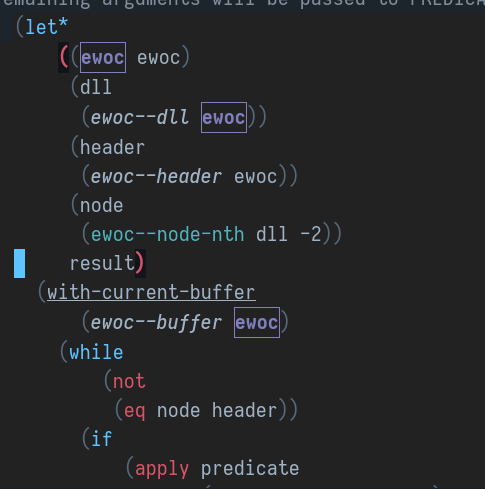什么是 compiler macro
在Elisp里, 我们通常会使用两种构造抽象的方式, macro和function. 这两者的区别相信读 者都已经了然于胸 (如果你不清楚, 建议查阅Elisp Reference Manual).
简言之, compiler macro可以在字节码编译时用特定的规则展开行如(func arg1 arg2 arg3)
的函数调用, 宏调用不会被compiler macro展开, 因为你可以在宏体里直接指定代码变换的
方式, 无需借助compiler maro的威力 :).
注意: 通常来说只有标准形式(func arg1 arg2)的函数调用才会被compiler macro打开优
化, 类似mapcar或者apply funcall的高阶函数调用, compiler macro将无能为力
是不是听着很熟悉? 是的, compiler macro可以做到内联优化, 尽管Elisp编译器很笨拙,但 所幸他给我们这些性能狂人留下了很多手动操作的空间.
compiler macro并不能算作与macro和function类比的组织抽象的方式, 只能算作Elisp 为 我们提供的函数优化器, 它没有自己独立的语义, 而是依附于函数而存在.
NOTE:
一个例外是(funcall #'func 1 2) 或者(apply #'func '(1 2 3 4)), byte-compiler
会消除掉这种funcall或者apply, 然后交给compiler macro展开.
如何察看compiler macro的展开结果
macroexpand
macroexpand macroexpand-1 macroexpand-all 可以打开直接compiler macro.
ELISP> (macroexpand-all '(cadr '(1 3)))
(car
(cdr
'(1 3)))
这里用cadr举例子, cadr可以取出列表中第二个元素, 等效于取列表的cdr的car.
可以看出来compiler macro直接把cadr展开成(car (cdr x))
ELISP> (macroexpand-all '(mapcar #'cadr '((1 2) ((3 4)))))
(mapcar #'cadr
'((1 2)
((3 4))))
在这里, cadr作为mapcar的参数使用, compiler macro就无能为力了.
cl-compiler-macroexpand
但是有时候你可能希望不要打开常规宏, 只打开compiler macro, 这时可以使用cl-lib中提
供的cl-compiler-macroexpand
ELISP> (cl-compiler-macroexpand '(cadr '(1 2)))
(car
(cdr
'(1 2)))
ELISP> (cl-compiler-macroexpand '(if-let* ((a (cadr '(1 3)))) a))
(if-let*
((a
(cadr
'(1 3))))
a)
对比
ELISP> (macroexpand-all '(if-let* ((a (cadr '(1 3)))) a))
(let*
((a
(and t
(car
(cdr
'(1 3))))))
(if a a))
macrostep
macrostep 可以展开compiler macro, 在 macrostep里, compiler macro和macro会用不同的face来标记

这里, 图中斜体字标记的时compiler macro, 下划线标记的是macro
如何编写compiler macro
compiler macro的定义
compiler-macro的定义和常规宏一样, 是一个返回一个s表达式的lambda, 这个lambda接收 的参数数量视用户调用compiler macro对应的函数时传入的数量而定. 第一个参数固定为要展开的form, 其余的参数依次为用户传入函数调用的参数.
compiler-macro symbol property
为了使compiler macro生效, 你需要将你定义的compiler macro设置为目标函数symbol的
compiler-macro property上.
(defalias 'my-list 'list)
(put 'my-list 'compiler-macro
(lambda (form &rest args) (message "Form: %S, ARGS: %S" form args)
form))
(cl-compiler-macroexpand '(my-list '(1 2 3 4)))
当我们展开compiler macro时, 会得到信息
Form: (my-list 1 2 3 4), ARGS: (1 2 3 4)
当你的compiler macro只用于一个函数, 一般可以忽略掉form直接用args.
declare form
在Emacs 24.4 或更高版本, 你可以直接在函数的declare form中指定compiler macro,
详见manual
实战
my-list* 函数
考虑函数my-list*, 它接受任意数量的参数, 将他们从头用cons连接到尾部.
我们的初版函数是这样的.
(defun my-list* (&rest args)
(let* ((rargs (reverse args))
(result (car rargs)))
(dolist (arg (cdr rargs))
(push arg result))
result))
(my-list* 1 2 3) ;=> '(1 2 . 3)
(my-list* 1 2 '(3)) ;=> '(1 2 3)
我们可以用高阶函数把它变得更简洁
(require 'cl-lib)
(defun my-list* (&rest args)
(cl-reduce #'cons args :from-end t))
你可能已经看出来,my-list*等效于手写(cons arg1 (cons arg2 (cons arg3 ...))).
另一方面, 我们都知道打开的循环比循环更高效, 但是我们完全没有必要为了性能而手写展
开形式, 更何况my-list*接受任意数量的参数, 根本无法直接手写展开.
这时候可以利用compiler macro生成sexp优化我们的my-list* 函数
(put 'my-list* 'compiler-macro
(lambda (_form &rest args)
;; 这里可以用`nreverse', 因为每次调用`(my-list* 1 2 3)'都会生成
;; 新的args, 而`(apply #'my-list* something)' 不会触发compiler macro
(let* ((rargs (nreverse args))
(head (pop rargs))
(result head))
(dolist (arg rargs)
(setq result `(cons ,arg ,result)))
result)))
来尝试一下
ELISP> (cl-compiler-macroexpand '(my-list* 1 2 3 4 5 6 6 7 8 9))
(cons 1
(cons 2
(cons 3
(cons 4
(cons 5
(cons 6
(cons 6
(cons 7
(cons 8 9)))))))))
可以看到我们写的compiler macro已经如愿展开了.
注意事项
警告: 在compiler macro中, 你可以随意修改函数展开的方式, 如果操作不当, 很可能会导
致直接调用函数与funcall调用函数时函数的行为不一致!
(defun my-id (x) x)
(put 'my-id 'compiler-macro
(lambda (_ arg)
`(list ,arg)))
;; Compiler macro不会在解释运行时展开, 这里使用`my-id'的原始定义.
(my-id 1) ;=> 1
(eval (byte-compile '(my-id 1))) ;=> (1) ???
(eval (byte-compile '(let ((f #'my-id)) (funcall f 1)))) ;=> 1
这里利用funcall规避了compiler macro展开, 由于我们的compiler macro不规范, 导致
(my-id 1) 和(funcall f 1)造成了不一致的结果, 请使用compiler macro的时候务必
注意, 小心不要造成undefined behaviour.
compiler macro in GV forms
由于macroexpand可以展开compiler macro, 因此setf也会打开GV form里的compiler macro
(defun my-aref (arr idx)
(aref arr idx))
(macroexpand-all '(setf (my-aref arr 1) 3))
;; => (let* ((v arr)) (\(setf\ my-aref\) 3 v 1))
(put 'my-aref 'compiler-macro
(lambda (_ arr idx)
`(aref ,arr ,idx)))
(macroexpand-all '(setf (my-aref arr 1) 3))
;; => (let* ((v arr)) (aset v 1 3))
我们用my-aref简单包裹了aref函数, 然而Emacs并不会进入我们的函数定义去查看我们
实际进行的动作,emacs只会去寻找my-aref的gv-setter, 并且在找不到的情况下使用了
setter的默认值(setf my-aref)(当然这里我们没有定义),
而使用了compiler macro后, 我们给编译器足够的提示, 成功my-aref被打开成对应的
aref Emacs已经定义了aref的gv-setteraset, setf就可以直接使用aset作为
my-aref的gv-setter
define-inline
为了更好的利用compiler macro, Emacs 25提供了inline.el, 作为compiler的上层包装,
协助用户更好更简单写出安全的内联函数.
inline-quote
用define-inline 定义函数类似于定义一个宏, 不过用inline-quote代替 `
在inline-quote中, 你只能使用,而不能使用,@, 这是为了防止生成的compiler
macro意外的破坏函数语义.
用define-inline重新定义刚才提到的my-aref
(require 'inline)
(define-inline my-aref-inline (arr idx)
(inline-quote (aref ,arr ,idx)))
(my-aref-inline [1 2 3] 0) ;=> 1
(macroexpand-all '(setf (my-aref-inline arr 1) 3)) ;=> (let* ((v arr)) (aset v 1 3))
用macroexpand-all 直接打开我们定义my-aref-inline的过程,得到
(progn
(defun my-aref-inline
(arr idx)
(declare
(compiler-macro my-aref-inline--inliner))
(aref arr idx))
:autoload-end
(eval-and-compile
(defun my-aref-inline--inliner
(inline--form arr idx)
(ignore inline--form)
(catch 'inline--just-use
(list 'aref arr idx)))))
可以看出来底层还是用的compiler macro的机制.
inline-letevals
考虑函数
(defun pow2 (num)
(* num num))
如何用define-inline定义其内联版本?
尝试直接用inline-quote
(define-inline pow2-inline (num)
(inline-quote (* ,num ,num)))
(pow2-inline 3) ;=> 9
(pow2-inline 2) ;=> 4
(eval (byte-compile '(pow2-inline 2))) ;=> 4
看起来没有问题, 继续测试
(defun my-side-effect-2 ()
"Do a message, and return 2."
(message "Side effect!")
2)
(eval (byte-compile '(pow2-inline (my-side-effect-2)))) ;=> 4
这里, message "Side effect!"被发送了两次, 我们用macroexpand打开pow2-inline看
看
(*
(my-side-effect-2)
(my-side-effect-2))
看起来我们的参数(my-side-effect-2)被直接内联到了*的两个参数位置里, 造成
my-side-effect-2 被求值两次, 这显然不是我们想要的结果.
对于这种情况, define-inline 为我们提供了inline-letevals 来控制一个表达式只被
计算一次
(define-inline pow2-inline-2 (num)
(inline-letevals (num)
(inline-quote
(* ,num ,num))))
(eval (byte-compile '(pow2-inline-2 (my-side-effect-2)))) ;=> 只有一次"Side Effect!"
展开pow2-inline-2的调用
(let ((print-gensym t)
(print-circle t))
(prin1-to-string (macroexpand-all '(pow2-inline-2 (my-side-effect-2)))))
;; => "(let* ((#1=#:num (my-side-effect-2))) (* #1# #1#))"
可以看出来inline-letevals类似与我们编写macro时用let和gensym保护expression的方
式.
使用function+compiler-macro与直接使用macro的区别
从语法上看macro不能作为高阶函数的参数使用(当然你可以拐着弯用lambda包裹macro). 而 function可以.
compiler macro和macro一样, 会被Emacs的Eager macroexpansion机制打开.
在老版本的Emacs中, 有人喜欢用宏替代内联函数, 这在新版本中的Emacs完全没有必要, 函
数和宏完全是两种不同语义的东西, 如果你需要内联函数优化, 请使用compiler macro, 或
者define-inline这种上层包装.
用compiler macro做内联和使用defsubst的内联有什么区别?
defsubst是另一种定义内联函数的方式, 对比compiler macro, defsubst内联的方式更
为保守.
defsubst 无法用macroexpand展开, 因此defsubst定义的inline function不能作为
setf的form.
比如, defsubst会保持lisp function对argument严格从左到右求值的逻辑. 同样也会建
立函数专有的变量作用域. 比如上文用来举例的pow2-inline, 用defsubst可以直接定
义为
(defsubst pow2-subst (num)
(* num num))
(eval (byte-compile '(pow2-subst (my-side-effect-2)))) ;只有一次"Side Effect!"
使用compiler macro时, 求值策略是由用户自行决定的.
(defun say-is (somthing type)
(message "%s is %s" something type))
(define-inline simple-case (something type)
(inline-letevals (something)
(inline-quote
(cl-case ,something
((donkey (say-is ,something ,type)))
((rabbit (say-is ,something ,type)))))))
这里我们没有用inline-letevals保护type变量, 因为我们知道cl-case的两个分支不可
能同时执行, 而type被作为函数say-is的参数, say-is会将其eval. 这样我们就达成了
类似lazy evaluation的效果
